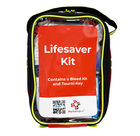How is Woundclot Different from Chitosan-Based Haemostatics
Unlock This Video Now for FREE
This video is normally available to paying customers.
You may unlock this video for FREE. Enter your email address for instant access AND to receive ongoing updates and special discounts related to this topic.
WoundClot: The Advanced Chitosan-based Haemostatic Solution
Chitosan-based Haemostatics: An Overview
Chitosan-based haemostatics consist of a non-resorbable, non-woven fiber infused with chitosan, an active ingredient derived from the hard outer skeleton of shellfish such as crab, lobster, and shrimp. These products primarily operate through a single mechanism of action, which involves attracting negatively charged red blood cells using its positively charged ingredients.
WoundClot: Unleashing Multiple Mechanisms of Action
WoundClot sets itself apart by employing a range of mechanisms to promote effective haemostasis:
- Rapid Fluid Absorption: WoundClot swiftly absorbs fluids within the wound area.
- Adherence and Expansion: WoundClot adheres to the wound surface and expands, ensuring comprehensive coverage.
- Aggregation of Platelets, Red Blood Cells, and Clotting Factors: WoundClot facilitates the aggregation of platelets, red blood cells, and clotting factors, fostering an optimal environment for clot formation.
- Activation of Key Clotting Factors: WoundClot activates the two key clotting factors, further enhancing the clotting process.
Prolonged Absorbency and Efficiency
WoundClot exhibits exceptional absorbency and lasting effectiveness:
With its active absorbency enduring for up to 24 hours, WoundClot remains efficient throughout the wound healing process.
With its diverse mechanisms of action and sustained absorbency, WoundClot represents a cutting-edge advancement in the realm of haemostatic solutions.
_-Trauma_8x20_CE.jpg)






